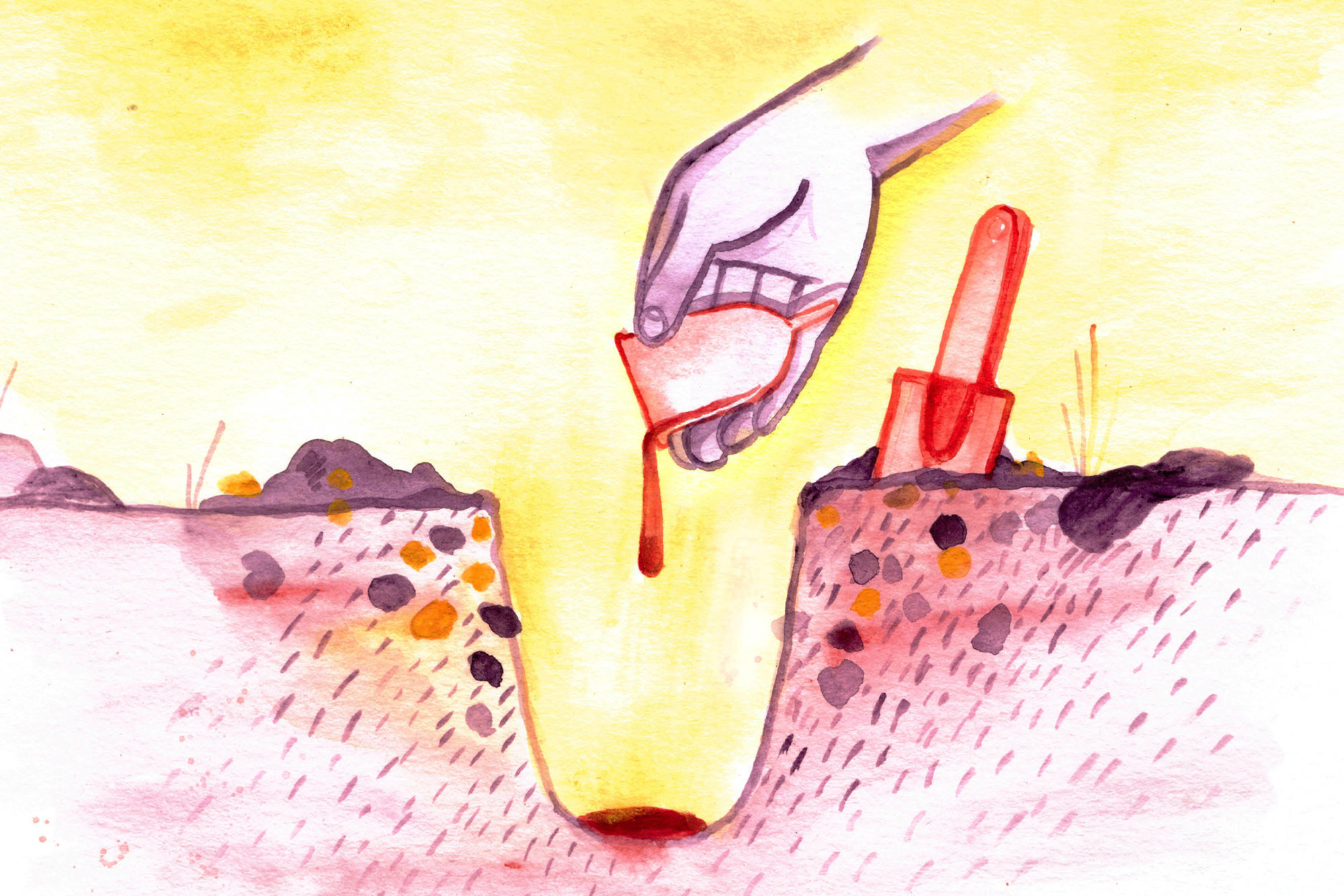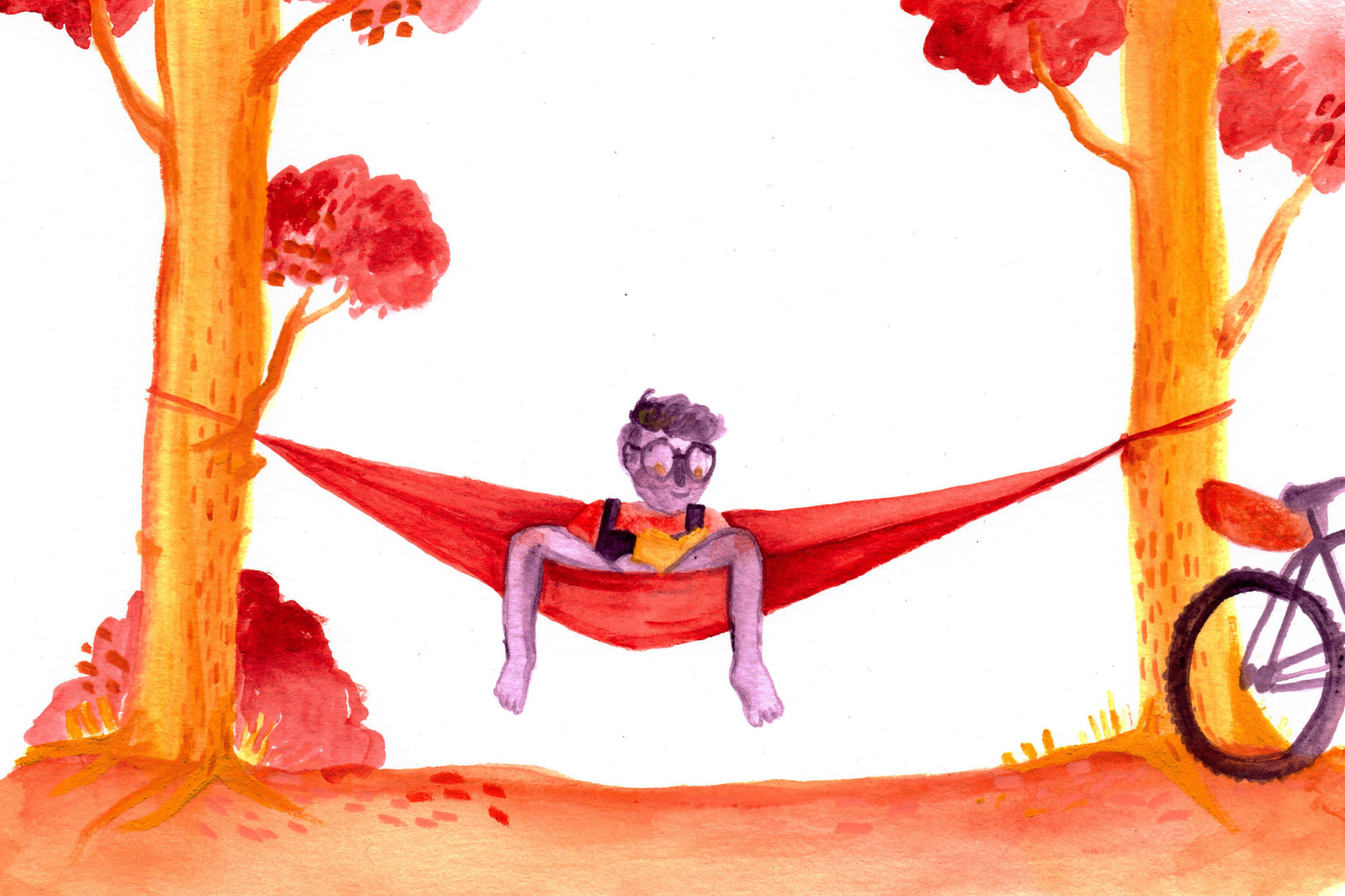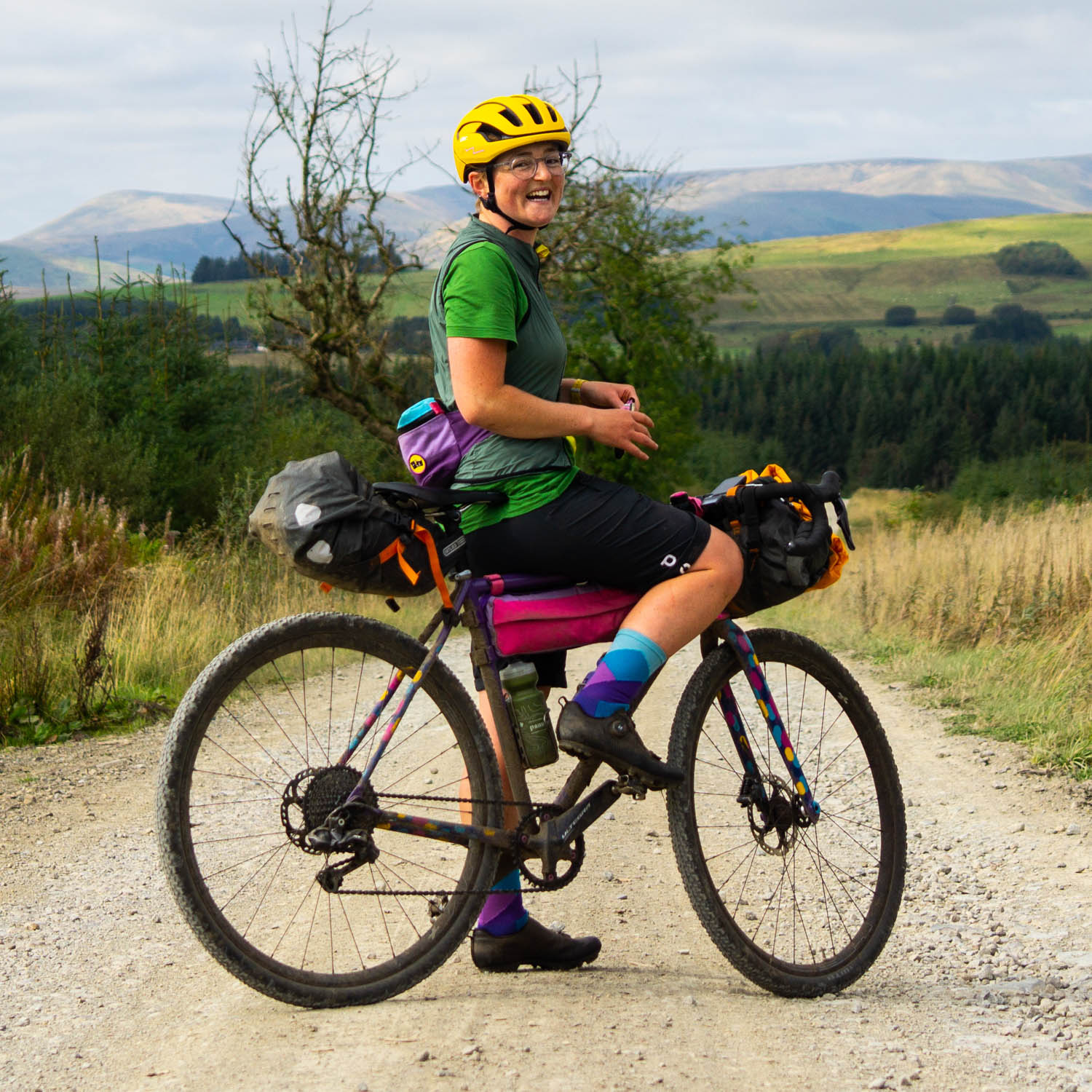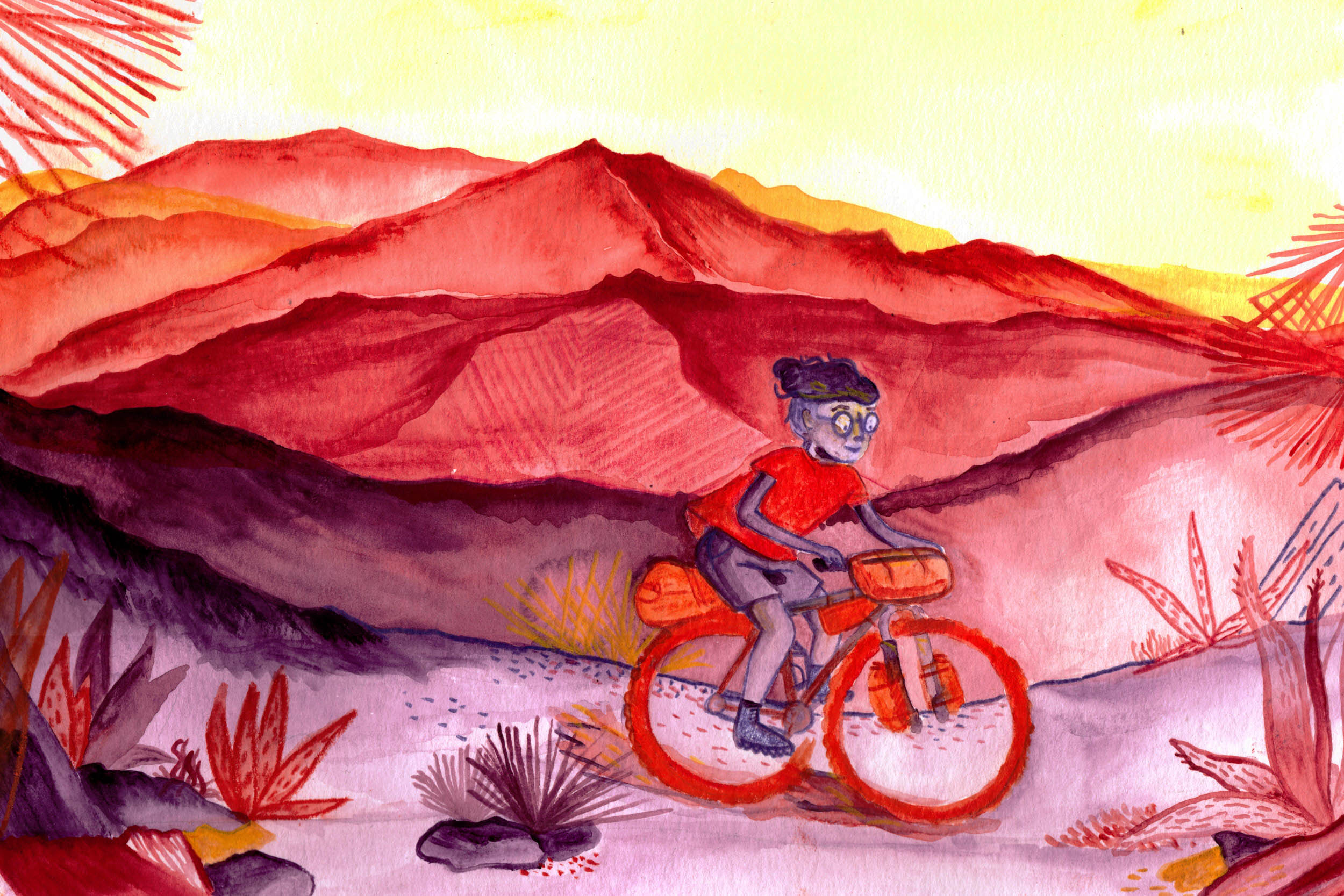A Guide to Bikepacking on Your Period
Share This
Periods affect roughly half the population and have significant impacts in sports, but are rarely talked about. In this Guide to Bikepacking on Your Period, Katherine Moore shines some light on the subject, providing insight and tips, plus feedback from several riders and racers…
Words by Katherine Moore (@katherinebikes), illustrations by Adeline O’Moreau (@ecunard)
Table of Contents
I. More Than Blood
Symptoms and effects
II. Some Solutions
Tools, how-tos, and tips from other bikepackers
III. Excercise vs Rest
Benefits and managing intensity
IV. Choose Your Foods Wisely
Cravings, beneficial foods, and what to avoid
V. Acceptance
How to roll with it
VI. Help Out Your Friends
How to be supportive
Periods are curious things. Unlike most natural and healthy phenomena in the human body, they can inflict pain and discomfort even when functioning perfectly. Occurring so routinely and commonly affecting such a significant proportion of a person’s life, it’s a wonder we don’t talk about them more.
In fact, that’s a huge part of the problem. Somehow, there’s a stigma in the 21st century about discussing periods. Mental health difficulties are said to affect one in four people in the UK each year (1), and many awareness schemes over the last decade have done a great job in de-stigmatising the way we talk about mental wellness. It’s now time for the same to happen with menstruation, which we know affects nearly one in two people every month.
Put this into the context of bikepacking, which often involves long-distance rides that inevitably coincide with menstrual cycles. In this guide, we’ll explore the diverse ways that periods affect people and the challenges they pose, before listing some practical tools and methods for learning to manage them whilst out bikepacking.
It’s natural, so what’s the problem?
To start, let’s go back to basics. Forget for a moment the body-doubling stomach cramps, lethargic limbs and violent mood swings that can take even the most loving relationship to near breaking point.
Menstruation occurs in ovulating females between puberty and menopause, on average from early teens to late 40s or 50s. That’s up to four decades of cycles—on average every 28 days—that typically last between a few days and a week. During this time, the body will pass between 5 and 12 teaspoons of blood through the vagina. This blood is the degraded lining of the uterus, which thickened to receive the implantation of a fertilised egg. For every month of sexual maturity when an egg is not fertilized, it is passed out of the body along with this tissue as menstrual fluid.
More than blood
To think that a few days of bleeding is the only result of a period is a common misconception. In fact, the balance of hormones throughout the monthly cycle has wide-ranging effects on the body.
What’s important to remember is that every person’s experience is unique. During the time of menstruation, there are several common side-effects that accompany the natural and healthy process of passing menstrual fluid. These may include:
- Muscle cramps
- Headaches
- Tender breasts
- Bloating
- Joint pain
- Bad skin
- Diarrhea or constipation
And that’s just during menstruation. Another time that’s referred to is the week before, when many people experience premenstrual syndrome or tension (PMS or PMT). Over 90% of menstruating people claim to have experienced symptoms of PMS, which can be physical or emotional, and includes:
- Swollen or tender breasts
- Constipation or diarrhea
- Bloating
- Muscle cramps
- Headache or backache
- Lower tolerance for noise or light
- Irritability or hostile behavior
- Tiredness
- Sleeping too much or little
- Appetite changes or food cravings
- Trouble with concentration or memory
- Tension or anxiety
- Depression, feelings of sadness, tearfulness
- Mood swings
- Reduced interest in sex
“I seem to completely let my period take over, as my PMS has gotten worse as I’ve gotten older and is probably just as much an issue as the period itself, if I’m being honest. It’s so frustrating! I do really find being on the bike definitely helps with my cramps and my PMS, though, and will usually still go riding if I can. The one super heavy day I get is usually a no-go simply because I usually feel gross AF, but I’d like to change this.” —Hannah, cycle tourer, Wales
Yikes, that doesn’t sound like a lot of fun. But it doesn’t necessarily have to stop you from riding.
Some Solutions

In addition to the everyday tampons and sanitary pads, a few painkillers and perhaps a hot water bottle, what other options are there, especially for active bikepackers? We spoke to a range of people from across the world to see what works for them.
Disposable tampons and towels
The traditional approach to managing your period involves single-use tampons and sanitary towels or pads. If going down this route, remember to take your used items home or dispose of your waste responsibly. While travelling in areas where there are no bins, make sure you pack enough supplies and make your own waste bag to carry used tampons and towels. Add tea bags or crushed aspirin to this to help control odour. Remember that using pads may cause chafe during your ride, and consider opting for applicator-free tampons to reduce waste on your trip.
Menstrual Cup
Sounds pretty good, right? Many bikepackers advocate the use of a cup, but be aware that there are some circumstances where they might not be suitable. For instance, some users might find application awkward, and they can potentially cause irritation if you have any vaginal damage from childbirth.
“I have used a moon cup for about four years now, and it has changed my life. I’ve done numerous sporting events on my period when previously I would have to pick dates for events that didn’t coincide because I couldn’t ride with a tampon, needed to change it too often or felt too sore or sick. My cup is so much more comfortable on the bike or running than a tampon, and I’m sure it makes my cramps slightly less painful.” —Ricky, New Zealand
“After using a moon cup for many many years, I’m surprised to hear some ladies didn’t know about it or didn’t think it’s suitable for cycling! Looks like more education is needed on the topic. I have very painful periods, it’s an extra hassle. I get by okay on my daily life, but racing is another story!” —Ingrid, ultra endurance racer, UK
“I’ve been a working messenger for about six years. Dealing with periods during work is a huge pain in my ass on top of working hard on a bike! I use tampons but am hesitant to swap over to a diva cup – something about it being so foreign to me and sort of scares me. Crazy cause there’s nothing to be scared of, I suppose.” —Carajo, bike messenger, New York

Wearables
There are a number of different brands like Thinx, Modibodi and Dear Kate that offer wearable absorbent clothing, from underwear to leggings. Besides being washable, reusable and much better for the environment than single-use options, they can also be used in conjunction with menstrual cups or tampons as a back-up on heavier flow days.
If you ride without a chamois, these could be an option for you, but might be less favourable to use with padded shorts (as anyone who’s accidentally ridden with underwear under bibs would probably say)! You may need to take several pairs so you can wear them on rotation whilst washing.
Free bleeding
To have your period without using tools such as tampons, pads, cups or wearables is termed ‘free bleeding’. This may be more suitable for you on lighter days at the beginning or end of your period when internal measures could be less suitable, or when some of these methods could cause chafing or discomfort. This term also refers to the act of openly bleeding in public as an act of protest, often to challenge period taboos.
“Given the choice, I use cloth sanitary pads, and wear period pants for exercise, or I free-bleed on lighter days and wear merino underwear that’s easily washed and naturally antibacterial. Cycling is the anomaly because obviously I don’t want to wear anything under a chamois. Options are internal protection or free bleeding. Truthfully, I often just freebleed. It’s my chamois and I’ll do what I want, and I think women should have the courage and option to just be able to freebleed without judgement. That said, on heavier days, it’s unpleasant and it gets messy and so on. So, for heavier days or longer rides I’m back to tampons. Menstrual blood is actually very potent, so tampons that are biodegradable can just be treated the same way you treat your ‘solid waste’ whilst bikepacking. Get trowelling, basically. Love the Earth, return your blood to her – there are actually rituals in which women bleed freely on sacred patches of earth to bless it with fertility.” —Cathy, audaxer, bikepacker and mum, Brighton UK
Apps
You may have heard of apps like Clue, Flo or FitrWoman for recording and tracking your periods. Intelligent software can help you plot and predict not only your period days, but a range of other side effects. Knowing when you might be due can help form your travel plans – either making sure you have sufficient supplies or perhaps delaying a trip to when you feel at your best.
“A period tracker (Flo) has changed my life, because I never remember when it’s been or coming. Get a little notification three days before it’s due!” —Lucy, rider & bikepacker, Bristol UK
“A happy coincidence is that getting the plastic coil has made my periods so light that I barely notice them – minimal spotting. The mood change can still rear its head, so I still keep track with the Clue app, which helps to flag up when that mood change could be coming and reassured me that it’s not me, it’s my hormones.” —Alice, cycle tourer, Paris
“I have pretty bad cramps, so bad that my face goes red with the pain. My gyno prescribed prescription-strength ibuprofen and unfortunately that’s the only thing that prevents me curling up on the floor. I take one when they start and that’s usually all I need! I also track with the Flo app, so if I’m heading off on a trip I’ll have what I need.” —Fiola, racer and bikepacker, Europe
The FitrWoman app takes things a step further by marrying the menstrual cycle with a coaching platform. During the four stages of your period, it suggests optimal training and nutrition for that time, based on the hormonal changes in the body. For example, during your period it mentions a reduced recovery capacity due to inflammation, potentially disrupted sleep, heightened stress response and an increased appetite. The app then recommends a number of exercise types to help alleviate some of the side effects of this stage, including slow release carbohydrates to maintain blood sugar levels, and maintaining exercise, including yoga or pilates, which are shown to reduce PMS.
Contraceptives
Some contraceptive medicines and devices stop the normal menstrual cycle, which can result in a loss of periods. Whilst this can be pretty handy logistically on bike tours, there are a number of precautions to bear in mind, including long-term impacts on bone density, so any decision you make should be in close consultation with your doctor. Some riders use a period-delaying pill if there’s a particular event in mind when they want to avoid menstruation.
“The only time I’ve done a multi-day trip I was on the pill, so ‘planned’ my period around that. I took a break from the pill the week before the trip so I knew it was out of the way, as the amount of blood and the PMS was something did not want to be surprised by.” —Alice, cycle tourer, Paris
“I get a contraceptive injection every three months (I do it at home now), which means I don’t get periods, ever. Never ever having to worry about them is such a blessing.” —Jess, racer, runner and bikepacker, London
“I competed in the Transcontinental Race this year and took progesterone tablets for the three days leading up to the event and during to eliminate any of the usual symptoms I have from getting my period, such as nausea and bloating. However, I still had a light bleed for the usual length of time. I will use this method again for my next race. Out of competition, I train through it if I can. If not, I will take a day off training or possibly do an easy ride or gentle yoga. I’m a menstrual cup girl.” —Beccy, Ultra endurance racer, UK
“I have a mirena coil, so I don’t have periods. I recently had it replaced and the main reason was to keep having no periods whilst doing multi-day rides and races. I haven’t had a period in five years and I love it – one less thing to think about.” —Anon, MTB and bikepacking racer, UK
Exercise vs Rest
There’s plenty of evidence to show that exercise during menstruation can have mood-enhancing benefits through the release of endorphins – the same reason why chocolate can taste so good at this time! According to recent research from Strava and FitrWoman from 14,000 female athletes, 78% reported that exercise reduces the effects related to their monthly cycle (2).
Consider using the free app FitrWoman to learn more about how you can best train, recover and fuel your riding during the four main stages of your cycle. It’ll give you tailored advice depending on these stages, such as maximising your endurance training in the days before ovulation whilst reducing intensity.

Choose Your Foods Wisely
Cravings are nothing unusual for people on their periods, and the food you eat can make a significant difference to the way you feel. Experts suggest that you make sure you’re getting enough of these:
- Bananas: the magnesium-rich food can help reduce muscle cramps and regulate bowel activity
- Iron-rich vegetables: such as broccoli, which help replenish the iron lost in the blood during menstruation and help reduce fatigue and provide fibre and micronutrients
- Citrus friuts: oranges, lemons and limes are shown to help reduce anxiety, depression and cramping
- Eggs: the iron, essential fatty acids and vitamins in eggs make them a great food for menstruation, but avoid boiled eggs as these can promote bloating
- Oily fish: such as salmon, rich in omega-3 fatty acids, are particularly beneficial during your period for their anti-inflammatory properties
Research also shows that you should avoid too much of these foods:
- Spicy foods: these can upset your stomach and make you feel nauseous
- Excess sugar/processed foods: blood sugar spikes caused by the intake of high-sugar foods could negatively affect mood and make any bloating worse, so swap them out for fruits
- Alcohol: as your blood pressure may drop during your period, any effects of alcohol consumption may be exacerbated
- Caffeine: too many coffees or caffeinated drinks can negatively impact energy levels and sleep
“I started using Clue app last year, which helps to plan ahead, but I need to make sure to eat iron-rich products a few days before, lots of bananas, low fat diet, which helps with how bad cramping will get. Also, make sure to exercise day before and first day too, it makes period lighter.” —Ingrid, ultra endurance racer, UK
Acceptance
On a slightly different note, whilst it’s great to have options to manage your period and how that makes you feel, we also need to remember that it’s a totally natural, healthy and shame-free process. A massive 65% of respondents in the Strava/FitrWoman study felt that their performance was decreased either before or during their period. Rather than battle to maintain usual levels of fitness or energy, why not be mindful of your cycle and kind to yourself?
“I have struggled with my mood in the week before my period for a long time, and have tried various medications and contraceptives to no joy. Now I just accept that’s what it is, talk to my partner really openly about how I’m feeling, and because we’re touring for months at a time we carry on going. I accept that I’m not going to be as fast or springy, but that’s okay ‘cos I know no one’s judging me.” —Lucy, long distance tourer, UK (last seen in Denmark)
Help out your friends
Finally, it can’t be underestimated what a bit of compassion can do. Whether it’s your partner, girlfriend, friend or acquaintance, being supportive and understanding can make a trip – or everyday life – so much more enjoyable. Cathy puts it perfectly here:
“In terms of how people can be involved/supportive, please don’t shame your friends or girlfriends/partners for their natural bodily functions, even by making jokes about it. Menstrual blood is no more ‘gross’ than human urine and excrement (in fact, it’s a lot less gross) and if you’re a bikepacker you know how to shit in the woods, so please don’t shame or judge people for bleeding. Trust that if they want your help and advice they’ll ask for it, otherwise tactfully look the other way if they’re fumbling about in their bibs, and for god’s sake offer them some chocolate.” —Cathy, audaxer and bikepacker, Brighton UK
Wrap Up
We hope you’ve found this guide helpful, and perhaps it’s even given you a few ideas to try. Ultimately, there’s no one-size-fits-all solution, so do let us know in the comments how you approach your cycle during your tours, especially if you have any recommendations that could help others. And remember to always consult a medical professional if you have any concerns about your period.
If you’d like to find out more on the subject, we suggest you check out the work of Dr. Stacy Sims (author of ROAR), Emma Barnett (broadcaster, author of Period), and the FitrWoman blog. Thank you for reading this, talking about periods with your friends and family, and helping to crush the taboo!
1: McManus, S., Meltzer, H., Brugha, T. S., Bebbington, P. E., & Jenkins, R. (2009). Adult psychiatric morbidity in England, 2007: results of a household survey. The NHS Information Centre for health and social care.
2: https://blog.strava.com/press/exercise-to-feel-better-during-your-period-new-global-study-shows/

About Katherine Moore
Katherine Moore is a gravel rider and bikepacker from Bristol, UK, who measures her rides by stoke level rather than speed. There’s nothing she loves more than showing people great off-road routes and multi-day rides, especially in the UK. You can’t miss her – a love of bright colours means you’ll spot Katherine from a mile off! Find her at KatherineBikes.com or on Instagram @katherinebikes.
Please keep the conversation civil, constructive, and inclusive, or your comment will be removed.


























